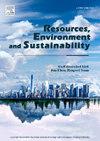土壤缺磷和贸易加剧了非洲的粮食短缺
IF 12.4
Q1 ENVIRONMENTAL SCIENCES
引用次数: 0
摘要
磷(P)是粮食生产和人口增长的关键营养素,特别是在非洲等营养不良地区。本研究估算了2000年至2020年非洲53个国家的磷流量,旨在了解磷对非洲粮食系统的历史影响。非洲拥有丰富的磷资源,在2000年至2020年期间,从磷矿中提取了1.25亿吨磷,其中摩洛哥占64%。尽管非洲有7900万吨磷肥以岩石或化肥的形式出口,但在此期间,非洲国家之间只有3%的磷肥在非洲生产。另外,有1200万吨磷肥被用于农业生产。在一些非洲国家,特别是埃塞俄比亚,集约化农业实践和磷化肥投入不足加剧了农业用地土壤磷的耗竭。近20%的粮食P是从其他大陆进口的,这表明供应链P贸易的趋势是从非洲作为低价值岩石出口,然后作为下游高价值食品进口。2050年情景分析表明,虽然通过降低粮食损失比例和改善饮食管理相结合可以减少492kt的磷需求,但只有增加肥料磷投入才能消除非洲未来的磷需求。因此,本研究强调非洲国家之间需要更密切的合作,以改善当地对磷资源的利用,消除非洲大陆的饥饿。本文章由计算机程序翻译,如有差异,请以英文原文为准。

Soil phosphorus deficits and trade exacerbate African food shortage
Phosphorus (P) is a critical nutrient for food production and population growth, particularly in regions with malnutrition such as Africa. This study estimated P flows across 53 countries in Africa from 2000 to 2020, aiming to understand the historical impacts of P on the African food system. Africa is endowed with substantial P resources, having extracted 125 Mt of P from phosphate rocks between 2000 and 2020, with Morocco accounting for 64% of this total. Despite 79 Mt of P in Africa being exported in terms of either rocks or fertilizers, only 3% of P produced within Africa was traded between African countries during this period. Additionally, 12 Mt of P were utilized for agricultural production. Intensive agricultural practices and inadequate P chemical fertilizer inputs have exacerbated soil P depletion in agricultural land in some African countries, especially Ethiopia. Nearly 20% of the food P is imported from other continents, which indicates a supply-chain P trade tendency of exporting from Africa as low-value rocks and then importing as downstream high-value food. Scenario analyses for the year 2050 suggest that while P demand can be decreased 492 kt through a combination of reducing food loss fraction and improving diet management, only increasing fertilizer P input could eliminate the African future P demand. Therefore, this study highlights the need for closer cooperation among African countries to improve local use of P resources and eliminate hunger within the continent.
求助全文
通过发布文献求助,成功后即可免费获取论文全文。
去求助
来源期刊

Resources Environment and Sustainability
Environmental Science-Environmental Science (miscellaneous)
CiteScore
15.10
自引率
0.00%
发文量
41
审稿时长
33 days
 求助内容:
求助内容: 应助结果提醒方式:
应助结果提醒方式:


